Continuous Development Learning and Professional Development
Added on 2020-10-23
47 Pages10481 Words348 Views
CAPSTONE PROJECT(DISS/CONS PROJECT/WORKBASED LEARNING)
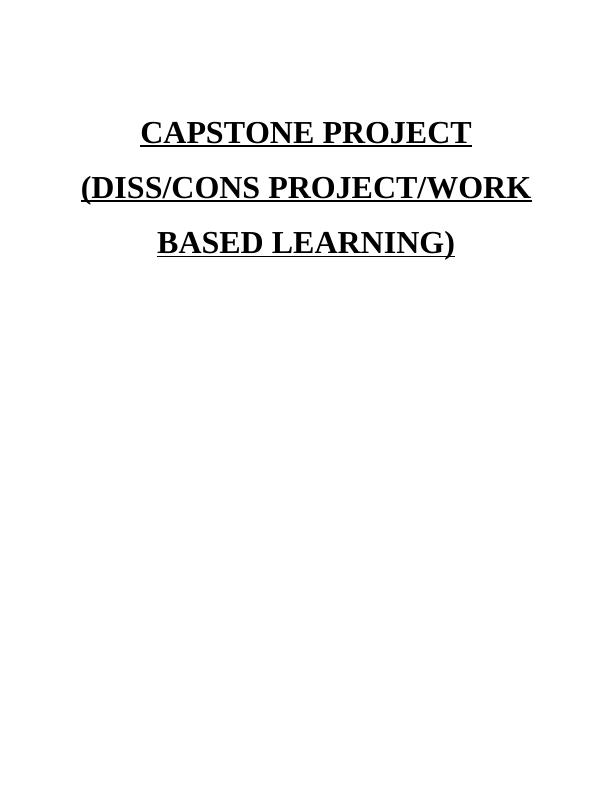
EXECUTIVE SUMMARYThe present report is based on Continuous development learning and professionaldevelopment that aids to build effective and efficient business working environment. This playscrucial role in terms to develop the morale of the employees and to perform the activitieseffectively. Therefore, the present report will cover aims and objectives in terms to understandthe role of continuous professional learning and development program in driving employeemotivation, productivity, job satisfaction, retention and performance.In this report, data analysis will be conducted in order to have depth and reliableinformation about to evaluate the relevance of continuous professional learning and developmentprogram in maintaining organisational competitiveness.
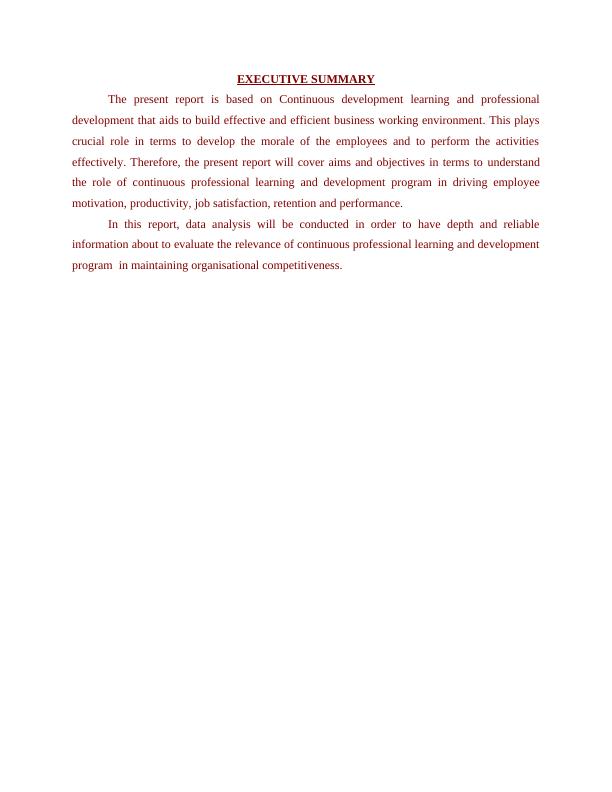
Table of ContentsCHAPTER 1: INTRODUCTION....................................................................................................1Background to Research.........................................................................................................1Research Aim.........................................................................................................................2Research Objectives...............................................................................................................2Research Rationale and Personal Rational.............................................................................2Research Question..................................................................................................................3Research hypothesis- .............................................................................................................3Introduction............................................................................................................................3CHAPTER 3: RESEARCH METHODOLOGY ..........................................................................10CHAPTER 4 .................................................................................................................................12DATA ANALYSIS .............................................................................................................12CHAPTER 5 CONCLUSION........................................................................................................41RECOMMENDATION ................................................................................................................41REFERENCES..............................................................................................................................43APPENDIX....................................................................................................................................45Gantt Chart...........................................................................................................................45.............................................................................................................................................45
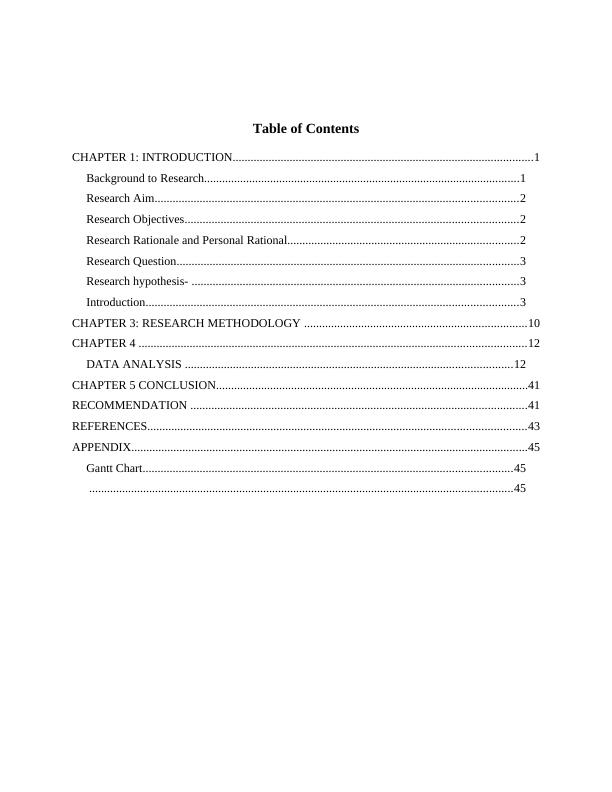
CHAPTER 1: INTRODUCTIONBackground to ResearchThe business environment is constantly changing, and research shows that humanresource management (HRM) function plays an important role in developing the workforce andmaintaining a competitive advantage. According to Davies and Preston (2002), companies thatprovide continuous professional development (CPD) programmes for employees can impact theiremployees positively and strengthen their interest to work in the company (Gibson, et al., 2010).CPD is the term used to describe the learning activities that professionals engage in as part oftheir organisational roles. Organisations develop CPD programmes in order to enhance the skillsand expertise of the employees. Rossi (2015), in a study on IT staff, describes CPD as a goodinvestment for organisations. The motivational level of the employees is increased when they getinvolved in such programmes as they develop a perception in their minds that this developmentwill serve them in the future. With the help of CPD, they can easily apply for the higher jobswithin the company as well as in other companies in the industry (Shaw & Green, 1999). The role of HR is to develop and support business strategy in the organisation to achievethe business goals and to gain a competitive advantage. Also, human resources managementconstitutes a vital role in strategic management, formulating the decision-making process,recognising the problem, coaching, and development plus employee’s incentives (Rasim, 2008).Therefore, it is imperative for an organisation to have a solid human resourcesmanagement team which will embark on the employee's development and training. The qualityof an organisation’s CPD offerings can enhance the positivity of the staff, and this will result inthe improvement of employee's productivity and growth in the workforce (Ichniowski, et al.,1995). Analysed the business environment as developing companies that encourage theemployee to adjust and grow continually with the organisation will give a competitive edge tostaff retention (Lengnick-Hall, et al., 2009). The organisation focus remains on the learning, training and making people fit for theorganisation and its profile. The major aim of the learning organisation is to make people fullyadaptive to the company and its changing nature and environment. The focus in organisationallearning should be on the individual skills and capacities rather than existing company imageand its policy (Aguinis & Kraiger, 2009). 1
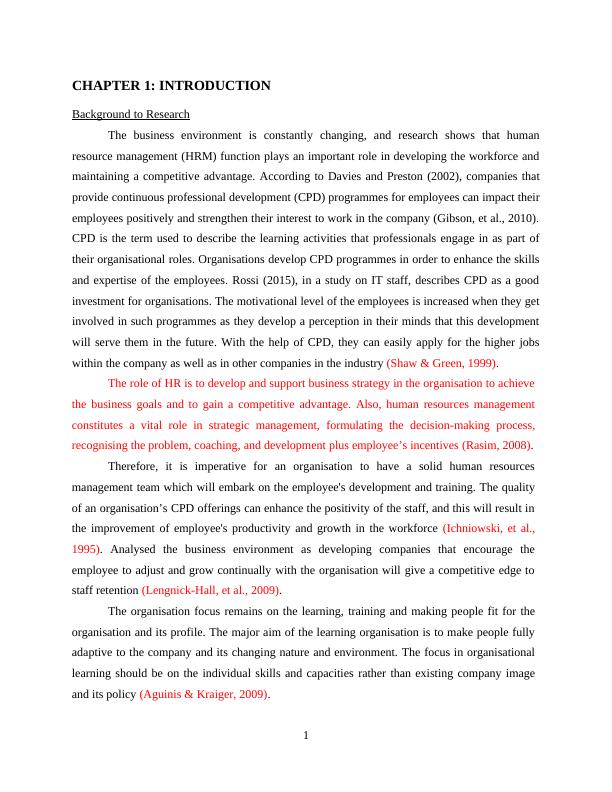
It is evident that the learning organisation aims for the continuous learning of itsadaptation and mainly change. For the small business, the creation of culture and its learning incontinuous training develops the change that system organisation adapts throughout its system.Viewing the learning organisation as root for the change leads to the change in the organisation(Opfer & Pedder, 2010). Research AimThis research will evaluate the relevance of continuous professional learning anddevelopment program in maintaining organisational competitiveness. Research ObjectivesTo understand the concept of continuous professional learning and development.To determine learning and development in term to enahnce organisationcompetitiveness. To investigate the various types of continuous professional learning and developmentprogram implemented in organisation.To understand the role of continuous professional learning and development program indriving employee motivation, productivity, job satisfaction, retention and performance.To evaluate relationship between continuous professional learning and developmentprogram and competitiveness of association in industry.Research Rationale and Personal RationalReason behind conducting research on this topic is to understand importance ofcontinuous professional learning and development program in current market. These dayschanges are taking place in external environment, so trend for continuous professional learningand development is improving. Apart from this there is personal reason as well to conductresearch on this topic. i.e. researcher belongs to HR field, so he wants to enhance knowledgeabout factors which motivates and make workforce retain in organisation. Continuous professional learning is the process of tracking and documenting the skills,knowledge and experience that an individual can gain both formally and informally whileworking, beyond any initial training. It's a record of what a person has experienced, learn and2
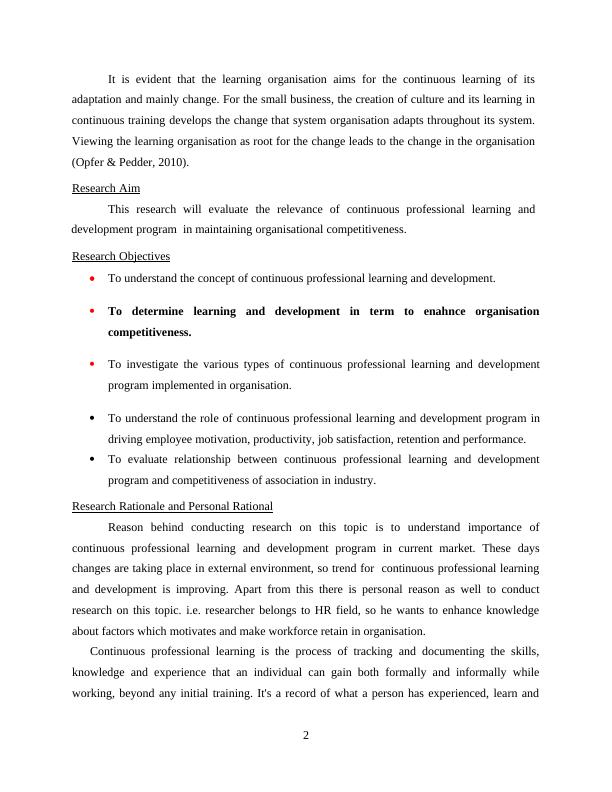
then applied in their practical life. The world of continuing professional development (CPD) ischanging, driven by digital enables and the changing demands of employers and workers alike.Demand is now generated in part by careerist professionals who see CPD as an extra way to gainadvantage in a competitive jobs market, while other trends are turning CPD into a means ofvalidating citizens’ expectations of public sector practitioner standards.Research QuestionDoes continuous professional learning and development increase an organization’s competitiveadvantage? Research hypothesis- H1- There is significant relationship between continuous professional development andorganisational competitive.H0- There is no significant relationship between continuous professional development andorganisational competitiveness. CHAPTER 2: LITERATURE REVIEWIntroductionSecondary data is best utilized through the development of literature that analyses,recounts and critiques the researches and information noted by other researchers on the topic. The concept of continuous professional learning and developmentAccording to Filipe (2014) continuous professional development is the process oftracking and recording the skills of employees and developing a program which can assist themto perform their business duties with higher capabilities and expertise. According to researchconducted by Sexton (2017), the individual who works in IT industry is required to keep up todate concerning the latest technologies. There are a diverse range of products and serviceswhich are provided to the customers of the company, and if the IT department of the companydoes not update their skills and expertise, then the company fail badly to satisfy the needs anddemands of the customers. To remain effective in their role they have to play specialconsideration to information technology by knowing the trends and changes in the technology(Olakulehin, 2007). The IT professional when keeping them updated when they become able tofulfil all the needs and demands of customers of the company. Moreover, their performance ofthe duty is also improved which enables them to grow in the company as well as in industry in3

the future (Anvari, 2007). As per the view of Aguinis & Kraiger, (2009) stated that CPDtermed out as planned, continuos and lifelong process that aidas to develop their personal andprofressional qualities and also aids to improve the knowledge, skills and practice that leads toempower teh working of the individuals. In contrary to Anvari, (2007) stated that this can bedefined as ongoing process that aids to develoing, maintaining and documenting theprofressional skill to conduct the work practices effectively. Hence, Creswell and Plano Clark,(2007) stated that continuing development can be termed out as the both potential expensiveand essential process. The main purpose of profressional development is to improvise theknowledge and skills in order to faciliates the individual and also supports to continuallyenhance the requirements. In contrary to Gibson, Dollarhide & Moss, (2010) stated thatcontinual profressional development is crucial process that aids to maintain and enhanceknowledge of the worker of the enterprise. According to the view of Ichniowski & Prennushi,(1995) stated that continuing profression development is effective process that aids to enhancethe skills and abilities of employees. It si one of the widely recognised process. It is process thatis very effective in terms to developing an understanding of the practical application applicationof the innovative knowledge and skills. As per the view ofKhan, Khan & Khan, (2011) stated that this is very crucial terms as it supports to tracking and documenting the skills,knowledge and experiencing. Therefore, this is term that defined as lifelong process hat aids toimprove and broaden the knowledge and skills of an individual within the enterprise. The various types of continuous professional learning and development programimplemented in organisationAccording to Burton (2017) the companies which make the investment in CPD enhances theexpertise of employees which in return decreases the expenses and costs of the companies. Themore competent and capable employees of the company work with higher efficiency andproductivity and do not find difficulty in dealing with the pertaining problems. In the specialissues, the companies also do not have to hire the external specialist to deal with the issues or toperform the specific task. In this way, the cost of hiring experts is also reduced. As theproductivity and efficiency of the employees are increased, they tend to work more in thelimited time which transforms the goals of the company into reality and assists the company to4

achieve the corporate objective. The highly productive companies save cost and become moreprofitable as compared to competitors. The cost-saving leads towards achieving a competitiveadvantage in the long run (Steadfast, 2017). The companies make the HR strategy which deals with the management of the employees of thecompany. The effective strategy of the company assists the management of the company insatisfying their employees and provoking them to work with high devotion and motivation. Asper research conducted by researcherthe highly motivated employees of the company workharder and leads towards the development and growth of the company. The higher satisfactiondevelops, the higher the motivation to work in the company in the long run. The continuousprofessional development also increases the level of motivation in the employees. Theemployees of the company who get involved in the CPD programs initiated by management aresatisfied to a greater extent as they perceive that they will grow easily in future due to developedskills and expertise (Nereida, 2013). The role of continuous professional learning and development program in drivingemployee motivation, productivity, job satisfaction, retention and performanceThe human resource strategy of the company is developed to manage the employees of thecompany. As per Priya & Eshwar, 2014 The employees of the company want the HR strategy intheir favour concerning pay scales, promotion plans, reward schemes, development of skills andexpertise as well as other non-monetary rewards. The companies which develop humanresources policies and strategy to motivate the employees and retain them for a longer periodgive special consideration to all these factors of motivation (Marinucci, et al., 2013). The highlymotivated employees’ works in the best interest of the company and perform their duties withfull devotion and productivity. According to Sexton, 2017 the training and development are an important andappreciable approach which can be used by the company to motivate their employees. Thetraining and development are incorporated within the organisation with the help of a continuousprofessional development program (Khan and et al., 2011). As the skills are increased whenthey find a way to deal with the issues of the work. In some situations, the employees get stuckspecifically at the time when the new technology or new approaches to work are introducedwithin an entity. The training and development resolve these issues. 5

End of preview
Want to access all the pages? Upload your documents or become a member.
Related Documents
Impact of Continuous learning and Developmentlg...
|20
|5083
|275
The Impact of Continuous Learning and Development on Organisation Competitivenesslg...
|16
|3810
|20
Developing Individuals, Teams and Organisationslg...
|14
|4484
|85
Developing Individuals Teams & Organisationslg...
|15
|5216
|156
CPD: Definition, Engagement, and Support in Organizationslg...
|19
|6519
|40
Developing Individuals, Teams and Organisationslg...
|23
|4514
|353